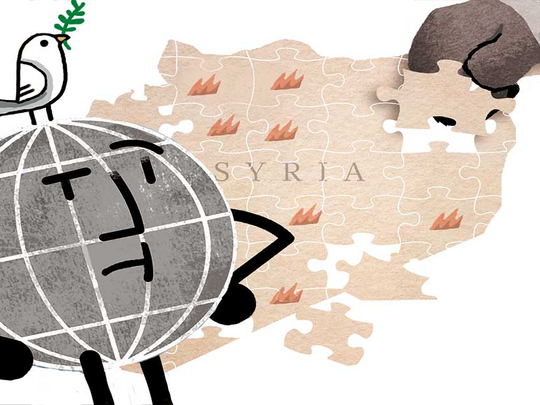
On May 4, Russia, Turkey, and Iran signed a new agreement in Astana on the Syrian crisis. The deal stipulates the implementation of four safe zones, also known as ‘de-escalation zones’, across the country, in parallel with a six-month truce. The agreement excludes Daesh (the self-proclaimed Islamic State of Iraq and the Levant) and the Tahrir Al Sham Assembly, the even more powerful successor to the Al Qaida-aligned Al Nusra Front.
There are many battles taking place across Syria that have nothing to do with the original belligerents — the government, and the opposition — but the de-escalation agreement only covers areas where the government and rebels are fighting each other. These four zones include areas in south Syria bordering Jordan, the rebel stronghold of eastern Gouta in Damascus, an enclave in northern Homs, and the extremist-dominated Idlib province, which is the largest and most volatile. The signatories to the deal, in a way, reflect the current realities on the ground. Currently, there are two pro-Al Assad states, and one-anti Al Assad state that is far more concerned with fighting the Kurds than it is about the fate of the government in Damascus. The deal proves that the government of Bashar Al Assad has won the Syrian civil war. And this is nothing new. But with Russia now leading efforts to end the crisis, the government’s win is being cemented.
This deal, however, will probably not endure. After the December 30, 2016 ceasefire deal signed in Astana by the aforementioned countries, clashes broke out between the government and the opposition in the Wadi Barada area in north-west Damascus. Many consider that to have ended the ceasefire. Besides, deals brokered in Geneva broke down even quicker than those in Astana. Similarly, since the signing of May 4 agreement, Syrian government forces recaptured territory in Hama, and a deal was reached between the government and opposition in the Damascus suburb of Barzeh to empty the area of opposition fighters so that the army could move in.
It is deals such as the one in Barzeh, and many others before it, that have proved to be more successful than the agreements brokered on the international stage, including those crafted by the Syrian government’s two main allies, Russia and Iran. Localised deals, often struck directly between government and opposition officials, have been taking place for 18 months, and have seen rebels evacuate certain neighbourhoods in exchange for safe passage or even amnesty. These agreements came about despite continued clashes across other parts of the country, and, as such, seem more viable. Barzeh is the latest of such deals, and follows others in towns and suburbs such as Moadamiyeh, Daraya, Al Waer, and the recently signed mega four-town deal (Fua, Kefraya, Madaya, and Zabadani).
War crime
Many of these deals have faced heavy criticism, with people citing the forced displacement of civilians from those towns as a war crime. But the Moadamiyeh deal, for example, saw 300 civilians originally from Daraya — including 60 rebels — moved to a nearby government-held town. Under that deal, the rebels laid down their arms in exchange for a government amnesty. There have been other instances of rebels giving up the fight in exchange for such amnesties.
Another case in point is the Al Waer deal, struck between the government and the opposition, to move 40,000 people over six months from the besieged suburb in Homs to opposition-controlled areas in Idlib, Homs, and Aleppo, and even government-controlled areas. This was the largest evacuation deal signed between the two warring sides. So far, thousands have been relocated, and, following the end of the six-month agreement, government forces are expected to enter the town and establish joint security with rebels.
These deals may not be ideal from the point of view of the opposition, and in some cases not even ideal for the government, as with the four towns deal, and the bombing of Shiite civilians who left the besieged towns of Fua and Kefraya en route to government-held Aleppo. But given the current realities on the ground, and the fact that there is little possibility of a nationwide opposition recovery, those deals effectively end the war for the people in those towns.
International peace efforts should continue; ultimately they are going to be necessary. Something similar to the Taif Agreement, which ended Lebanon’s 15-year civil war, will have to eventually be signed with regional and international facilitation. And local agreements in Syria may prove to be the building blocks for a grand international agreement. The international community should take them more seriously, and do the utmost to facilitate them.
Mohamed Hineidi is a senior analyst at The Delma Institute, a foreign affairs research house located in Abu Dhabi.












